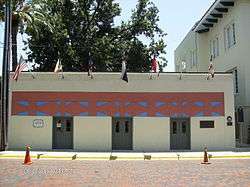Republic of the Rio Grande
| Republic of the Rio Grande | ||||||||||||||||||||
| República del Río Grande | ||||||||||||||||||||
| Unrecognized state | ||||||||||||||||||||
| ||||||||||||||||||||
| ||||||||||||||||||||
 | ||||||||||||||||||||
| Capital | Laredo | |||||||||||||||||||
| Languages | Spanish | |||||||||||||||||||
| Government | Republic | |||||||||||||||||||
| President | Jesús de Cárdenas | |||||||||||||||||||
| History | ||||||||||||||||||||
| • | Siete Leyes | January 17, 1840 | ||||||||||||||||||
| • | Camargo War | November 6, 1840 | ||||||||||||||||||
| Area | 300,000 km² (115,831 sq mi) | |||||||||||||||||||
| Currency | Peso | |||||||||||||||||||
| ||||||||||||||||||||
| Today part of | | |||||||||||||||||||
| Later moved to Guerrero, Tamaulipas, and in March 1840 to Victoria, Texas until disestablishment. | ||||||||||||||||||||
The Republic of the Rio Grande (Spanish: República del Río Grande) was an independent nation that insurgents against the Central Mexican Government sought to establish in northern Mexico. The Republic of the Rio Grande was just one of a series of independence movements in Mexico under Santa Anna's government, including the Texan Revolution, the Republic of Zacatecas, and the Republic of Yucatán. The rebellion lasted from January 17 to November 6, 1840 and the Republic was never officially recognized.
Background
After a decade of strife, Mexico won its independence from the Kingdom of Spain in 1821. After a failed attempt at a monarchy, Mexico adopted a new constitution, the 1824 Constitution. This new constitution established los Estados Unidos Mexicanos, or "the United Mexican States," as a federal republic. During the war for independence, many rebels were driven to Coahuila and Nuevo León, where this revolutionary mentality won the hearts and minds of the people.[1]
In 1833, General Antonio López de Santa Anna was elected to his first term as president and was, at the time of his election, in support of the federal republic. However, after some members of government angered Santa Anna's political allies, Santa Anna decided to start a centralized government.[2] Santa Anna suspended the constitution, disbanded Congress and made himself the center of power in Mexico. States were converted into departments without political or fiscal autonomy by replacing elected governors with appointed ones and substituting state assemblies for juntas under Santa Anna's policies. Dismayed by these policies and the perception that the government was deaf to the complaints and plight of the villagers in the North, republic leaders aimed to expel the government-appointed centralist officials and restore the Constitution of 1824.[3] On November 3, 1838, one of the republic leaders, Antonio Canales, issued a pronunciamiento against the government and in favor of federalism.
Resistance
In January 1839, Antonio Canales summoned a convention at the office of the Justice of the Peace in Laredo where the Constitution of 1824 was unanimously approved. Canales immediately began building an army and scoured the countryside looking for recruits, among those recruits were Texan Colonels Reuben Ross and Samuel Jordan.[4] Intending to use the property of the church and convents to pay volunteers,[5] Canales amassed a small army of vaqueros along the Rio Grande River, Cane Indians, and Texans. On October 3, Canales and his army marched to the town of Mier, where they faced the Mexican army. During the battle, Colonels Reuben Ross and Samuel Jordan charged at the centralist forces and encircled them in a hacienda, where the Mexican army was forced to surrender. Three hundred and fifty centralist soldiers who were taken prisoner ultimately defected and enlisted in Canales’ army.[6] After the battle, Canales was seen as a hero throughout Northern Mexico and many towns began to support his cause. Within a few days, recruits, supplies, and cash were being sent to him.[4]
Canales lingered in Mier for forty days before heading to Matamoros, a port town where another Centrist force was residing. In twenty-eight days, his one thousand man army reached the town only to find Mexican General Valentin Canalizo there with fifteen-hundred troops. Outmanned, Canales decided to withdraw and attack General Mariano Arista at Monterrey instead. Colonel Ross, appalled by this withdrawal, left Canales’ army, taking fifty Texans with him. At Monterrey, General Canales sends three hundred cavalry under the command of Colonel Jose Antonio Zapata to lure Arista out of town. While Arista left the town unguarded to engage with Zapata, General Canales’ army took a convent on the outskirts of town. However, on December 27, General Arista sent spies to Canales’ army and bribed seven hundred Mexicans to abandon their army. Upon discovering this the next morning, Canales and the remnants of his army fled the battle.[6]
Rebellion
A New Republic
On January 17, 1840 a meeting was held at the Oreveña Ranch near Laredo.[7] A group of notables from the states of Coahuila, Nuevo León, and Tamaulipas advocated for a rebellion seeking secession from Mexico and formation of their own federal republic with Laredo as the capital. However, those states' own congresses and governments never took any action to support the insurgents, and requested the help of the Central government in Mexico City to aid the local state armies.[8] Despite the lack of support from the state governments, the Republic of the Rio Grande was formed. The new Republic had an official newspaper: “Correo del Rio Bravo del Norte” and their state motto was Dios, Libertad y Convención (God, Liberty, and Convention).[1]
The insurgents designated their own officials for the new republic. They were:
- Jesús de Cárdenas, A former lawyer and political chief of the Northern Department of Tamaulipas. He was sworn in as president of the new Republic.
- Antonio Canales, The commander-in-chief of the new republic and one of the founding fathers of the republic.
- Juan Nepomuceno Molano, A council representative for Tamaulipas.
- Francisco Vidaurri y Villaseñor, A council representative for Coahuila.
- Manuel María de Llano, A council representative for Nuevo León.
- José María Jesús Carbajal, Secretary of State

Battle of Santa Rita de Morelos (March 24–25, 1840)
Shortly after the formation of the Republic of the Rio Grande, word arrived that General Arista was in the Rio Grande valley. Texan Samuel Jordan urged Canales to retreat to Texas to recruit more Texans but Canales refused. Consequently, Samuel Jordan and sixty of his men left General Canales’ army. While Canales and the army decided to fight, President Cardenas and the new government fled to Victoria, Texas.[6]
Canales and his army met Arista outside the town of Santa Rita de Morelos. Needing provisions, Antonio Zapata and thirty men rode into town where Arista’s men soon surrounded them. Outnumbered 1,800 to thirty, Zapata surrendered. General Arista offered to pardon Antonio Zapata under the condition that he swore allegiance to Mexico, but he refused. On March 29, 1840, Antonio Zapata was executed and his head placed on a spike in the town of Guerrero as a reminder to his wife, children, and federalists. While Zapata was being held prisoner, General Canales engaged Arista at San Fernando, losing two hundred fifty of his four hundred men in the process. After this defeat, Antonio Canales had no other option except to flee to Texas.[6]
Texas’ Role in the Rebellion
From the beginning, President Cardenas realized that the success of the Republic of the Rio Grande depended on Texan support.[4] Texas also had conflicting interests on whether to support the new Republic or not. On one hand, the formation of the Republic of the Rio Grande would create a buffer state between Mexico and Texas, postponing any possible intentions Mexico had for the reinvasion of Texas; on the other hand, Texas needed Mexico to recognize their independence and supporting the new Republic would certainly anger them. Texas’ official stance on the issue was neutral, but president Mirabeau Lamar secretly encouraged Texans to volunteer in Canales’ army and gave Canales access to Texan arms and ammunition.[9]
Battle of Saltillo (October 25, 1840)
In Texas, Canales rebuilt his new army at San Patricio under Colonel Samuel Jordan. The new army consisted of three hundred Mexicans, eighty Cane Indians, and four hundred and ten Texans. With the new army, Canales marched out of Texas and was able to recapture the towns of Laredo, Guerrero, Mier, and Camargo.
Soon after, Canales ordered three hundred and fifty men, under the command of Samuel Jordan and Canales’ brother-in-law Juan Molano, to steal horses for future operations. After Jordan and Molano sacked the city of Ciudad Victoria and installed a new state government, they marched to Saltillo where the Mexican General Montoya was residing. Unbeknownst to Jordan, Juan Molano had secretly switched sides and joined the centralist forces.
On October 25, 1840, the Mexican army under Montoya faced the army of the Republic of the Rio Grande under the command of Colonel Lopez (who had secretly switched allegiance to General Montoya as well). Colonel Lopez ordered Jordan and his men to move into a mountain gorge. Upon realizing the trap, Jordan, his men, and the remaining loyal vaqueros to the Rio Grande Republic turned around and took refuge in a hacienda. The Mexican army attacked the hacienda in full force but was unable to capture the Texans before they retreated. The Mexican army lost four hundred men attacking the hacienda while the Texans only lost five.[6]
Defeat
After the defeat at Saltillo, General Canales secretly entered negotiations with General Arista and on November 6, 1840, Antonio Canales surrendered at Camargo. Canales soon accepted a position as officer in Santa Anna’s army. As part of conditions of surrender, no harm would come to the property or safety of former members of the republic. The Republic’s debts would be assumed as well.[1] A few days after Canales surrender, President Cardenas and other officials entered into Laredo to officially surrender.
Flag of the republic

The flag of the Republic of the Rio Grande has a red hoist with three white stars run evenly along the hoist. The three stars represent the three states that seceded: Coahuila, Nuevo León, and Tamaulipas. The fly is split into a white upper fly and a black lower fly.
The republic as a tourist attraction
Remnants of the republic's effect can be seen in:
- Zapata County, Texas, as well as the city of Zapata are named in honor of Republic of the Rio Grande cavalry commander, Colonel José Antonio de Zapata.
- Republic of the Rio Grande Capitol Building Museum is located in Laredo, Texas.
- As an addition to the historical six flags over Texas, the Laredo Morning Times newspaper adds a seventh flag to its banner: the flag for the Republic of the Rio Grande.
See also
- Mexican Constitution of 1824
- Republic of Yucatán
- Filibuster (military)
- List of historical unrecognized states
- Antonio López de Santa Anna
- Republic of Texas
Notes
- 1 2 3 De La Garza, Beatriz (2013). From the Republic of the Rio Grande: A Personal History of the Place and the People. Austin: University of Texas Press. pp. 1–22 – via ProQuest ebrary.
- ↑ Wilfred H. Callcott, "SANTA ANNA, ANTONIO LOPEZ DE," Handbook of Texas Online , accessed September 23, 2011. Published by the Texas State Historical Association.
- ↑ Valerio-Jiménez, Omar (2012). River of Hope: Forging Identity and Nation in the Rio Grande Borderlands. Durham, NC: Duke University Press. p. 125.
- 1 2 3 Lindheim, Milton. "The Republic of the Rio Grande". Texas AMU. W.M. Morrison, Publishing Co. Retrieved November 1, 2016.
- ↑ “Northren Mexico—New Republic of the Rio Grande.” American Masonic Register and Literary Companion (1839-1847) 1, no. 43 (jun 27 1840): 338.
- 1 2 3 4 5 Coppock, Mike (2005). "The Republic of the Rio Grande". Wild West. History Reference Center. 18: 46–52 – via EBSCOhost.
- ↑ The text of the constitution is available in Dippel, Horst, ed., Constitutions of the world from the late 18th century to the middle of the 19th century America Vol. 1. Constitutional documents of the United States of America Pt. 6. Rio Grande – Texas, München Saur 2008, ISBN 978-3-598-35756-5, pp. 9–13, “Ley orgánica de la República del Río Grande (1840)”
- ↑ David M. Vigness, "REPUBLIC OF THE RIO GRANDE," Handbook of Texas Online , accessed September 23, 2011. Published by the Texas State Historical Association.
- ↑ Vigness, David M. “Relations of the Republic of Texas and the Republic of the Rio Grande.” The Southwestern Historical Quarterly 57, no. 3 (1954): 312-21.
References
- Anonymous (January 11, 2014), The Republic of the Rio Grande, Webb County Heritage Foundation External link in
|publisher=(help) - Antonio Canales Rosillo from the Handbook of Texas Online
- Antonio López de Santa Anna from the Handbook of Texas Online
- Coppock, Mike. 2005. “The Republic of the Rio Grande.” Wild West 18, no. 4: 46-52. History Reference Center, EBSCOhost (accessed November 1, 2016).
- De la Garza, Beatriz. From the Republic of the Rio Grande: A Personal History of the Place and the People. Austin, US: University of Texas Press, 2013. Accessed November 1, 2016. ProQuest ebrary. pp. 1–22.
- The Laredo Morning Times Online edition
- Lindheim, Milton. “Republic of the Rio Grande.” Waco, TX: W.M. Morrison, Publishing Co. Texas AMU. Accessed November 1, 2016.
- “Mexico – Filibustering: Republic of the Rio Grande,” Flags of the World.
- “Northren Mexico—New Republic of the Rio Grande.” American Masonic Register and Literary Companion (1839-1847) 1, no. 43 (jun 27 1840): 338.
- Republic of the Rio Grande from the Handbook of Texas Online
- “The Republic of the Rio Grande: A Story of Its Rise and Fall,” Sons of DeWitt Colony Texas.
- Valerio-Jiménez, Omar S. River of Hope: Forging Identity and Nation in the Rio Grande Borderlands. Durham, NC: Duke University Press, 2013.
- Vigness, David M. “Relations of the Republic of Texas and the Republic of the Rio Grande.” The Southwestern Historical Quarterly 57, no. 3 (1954): 312-21.
- Yahoo! News article mentioning Republic of the Rio Grande in a present-day context
Further reading
- Arambula, Odie (November 8, 2008). Gonzalez, Josh, ed. "ISSUU - The Zapata Times".
|chapter=ignored (help) - Jaques, Tony, ed. (2007). "Santa Rita De Morelos". Dictionary of Battles and Sieges: P-Z. Greenwood Publishing Group. p. 290. ISBN 9780313335396.
Coordinates: 27°31′N 99°29′W / 27.517°N 99.483°W

